
A navy or maritime force is the branch of a nation's armed forces principally designated for naval and amphibious warfare; namely, lake-borne, riverine, littoral, or ocean-borne combat operations and related functions. It includes anything conducted by surface ships, amphibious ships, submarines, and seaborne aviation, as well as ancillary support, communications, training, and other fields. The strategic offensive role of a navy is projection of force into areas beyond a country's shores. The strategic defensive purpose of a navy is to frustrate seaborne projection-of-force by enemies. The strategic task of the navy also may incorporate nuclear deterrence by use of submarine-launched ballistic missiles. Naval operations can be broadly divided between riverine and littoral applications, open-ocean applications, and something in between, although these distinctions are more about strategic scope than tactical or operational division.

The Royal Australian Navy (RAN) is the naval branch of the Australian Defence Force. Following the Federation of Australia in 1901, the ships and resources of the separate colonial navies were integrated into a national force, called the Commonwealth Naval Forces. Originally intended for local defence, the navy was granted the title of 'Royal Australian Navy' in 1911, and became increasingly responsible for defence of the region.
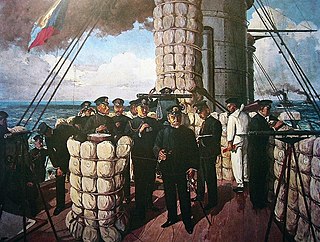
The Battle of Tsushima, also known as the Battle of Tsushima Strait and the Naval Battle of the Sea of Japan in Japan, was a major naval battle fought between Russia and Japan during the Russo-Japanese War. It was naval history's only decisive sea battle fought by modern steel battleship fleets, and the first naval battle in which wireless telegraphy (radio) played a critically important role. It has been characterized as the "dying echo of the old era – for the last time in the history of naval warfare, ships of the line of a beaten fleet surrendered on the high seas".

The Kirov-class battlecruiser is a class of nuclear-powered warship of the Russian Navy, the largest and heaviest surface combatant warships in operation in the world. Among modern warships, they are second in size only to large aircraft carriers, and of similar size to a World War 2 era battleship. The official designation of the ship-type is "heavy nuclear-powered guided missile cruiser". The ships are often referred to as battlecruisers by western defense commentators due to their size and general appearance.
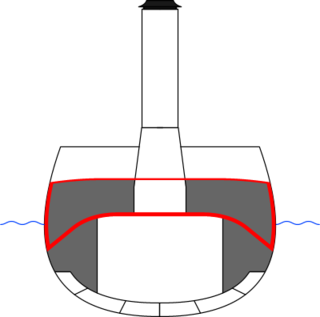
The armored cruiser was a type of warship of the late 19th and early 20th centuries. It was designed like other types of cruisers to operate as a long-range, independent warship, capable of defeating any ship apart from a battleship and fast enough to outrun any battleship it encountered. Varying in size, it was distinguished from other types of cruiser by its belt armor—thick iron plating on much of the hull to protect the ship from shellfire much like that on battleships. The first armored cruiser, the Imperial Russian Navy's General-Admiral, was launched in 1873 and combined sail and steam propulsion. By the 1890s cruisers had abandoned sail and took on a modern appearance.

The Navy of the Confederate States (CSN) was the naval branch of the Confederate States Armed Forces, established by an act of the Confederate States Congress on February 21, 1861. It was responsible for Confederate naval operations during the American Civil War (1861–1865), fighting against the Union Navy / United States Navy.
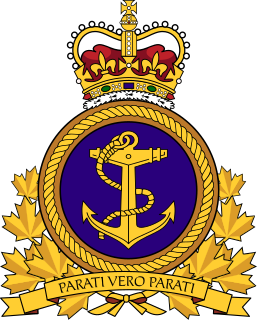
The Royal Canadian Navy is the naval force of Canada. The RCN is one of three environmental commands within the unified Canadian Armed Forces. As of 2017, Canada's navy operates 12 frigates, 4 patrol submarines, 12 coastal defence vessels and 8 unarmed patrol/training vessels, as well as several auxiliary vessels. The Royal Canadian Navy consists of 8,500 Regular Force and 5,100 Primary Reserve sailors, supported by 5,300 civilians. Vice-Admiral Ron Lloyd is the current Commander of the Royal Canadian Navy and Chief of the Naval Staff.

The French Navy, informally "La Royale", is the maritime arm of the French Armed Forces. Dating back to 1624, the French Navy is one of the world's oldest naval forces. It has participated in conflicts around the globe and played a key part in establishing the French colonial empire.

The Russian Navy is the naval arm of the Russian Armed Forces. It has existed in various forms since 1696, the present iteration of which was formed in January 1992 when it succeeded the Navy of the Commonwealth of Independent States.
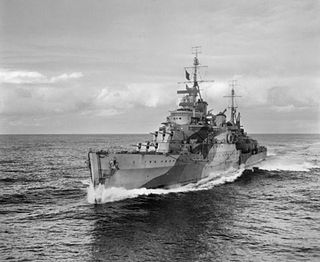
HMS Liverpool, named after the port city of Liverpool in north-west England, was a Town-class light cruiser of the Royal Navy in service from 1938 to 1952.

The Mackensen class was the last class of battlecruisers to be built by Germany in World War I. The design initially called for seven ships, but three of them were redesigned as the Ersatz Yorck class. Of the four ships of the Mackensen class, Mackensen, Graf Spee, and Prinz Eitel Friedrich were launched, and Fürst Bismarck was not—but none were completed, after wartime shipbuilding priorities were redirected towards U-boat—and the ships were broken up in the early 1920s. The lead ship of the class was named for August von Mackensen, a prominent military commander during the war. In response to the Mackensen-class ships, the British Royal Navy laid down the Admiral-class battlecruisers, all but one of which would eventually be cancelled; the sole survivor, HMS Hood, was completed after the end of the war.

The Romanian Navy is the navy branch of the Romanian Armed Forces; it operates in the Black Sea and on the Danube. It traces its history back to 1860.

The Battle of the Yellow Sea was a major naval battle of the Russo-Japanese War, fought on 10 August 1904. In the Russian Navy, it was referred to as the Battle of 10 August. The battle foiled an attempt by the Russian fleet at Port Arthur to break out and form up with counterparts from Vladivostok, forcing them to return to port. Four days later, the Battle off Ulsan similarly ended the Vladivostok group's sortie, forcing both fleets to remain at anchor.
USS Napa was a Casco class twin-screw light draft monitor built during the American Civil War for operation in the shallow inland waters of the Confederacy. These warships sacrificed armor plate for a shallow draft and were fitted with a ballast compartment designed to lower them in the water during battle.
USS Yuma, a single-turreted, twin-screw monitor, was laid down at Cincinnati, OH, by Alexander Swift and Co. and launched on 30 May 1865. A Casco-class, light-draft monitor, she was intended for service in the shallow bays, rivers, and inlets of the Confederacy. These warships sacrificed armor plate for a shallow draft and were fitted with a ballast compartment designed to lower them in the water during battle.
Admiral Sir Frederic Charles Dreyer, was an officer of the Royal Navy. A gunnery expert, he developed a fire control system for British warships, and served as flag captain to Admiral Sir John Jellicoe at the Battle of Jutland. He retired with the rank of admiral in 1943, having served through two world wars and having already retired once.
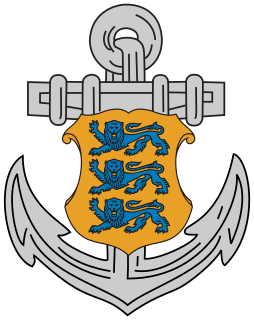
The Estonian Navy, is the name of the unified naval forces among the Estonia Defence Forces.

Rurik was an armoured cruiser built for the Imperial Russian Navy in the early 1890s. She was named in honour of Rurik, the semi-legendary founder of ancient Russia. She was sunk at the Battle of Ulsan in the Russo-Japanese War of 1904–05.

The Black Sea Shipyard is located in Mykolaiv, Ukraine. It was founded in 1895 by Belgian interests and began building warships in 1901. At the beginning of World War I in 1914, it was one of the largest industrial facilities in the Russian Empire. The shipyard was moribund until the Soviets began building up the fleet in the 1930s and it began building surface warships as well as submarines. The yard was badly damaged during World War II and took several years to be rebuilt. Surface warship construction temporarily ended in the mid-1950s before being revived in the mid-1960s and submarines were last built in the yard in late 1950s. The Black Sea Shipyard built all of the aircraft carrying ships of the USSR and Russia and continues to build large commercial ships.

The attack on Yokosuka was an air raid conducted by the United States Navy on 18 July 1945 during the last weeks of the Pacific War. The Japanese battleship Nagato was the raid's main target, though anti-aircraft positions and other warships at Yokosuka Naval Arsenal were also attacked. Other U.S. Navy and British Royal Navy aircraft struck airfields in the Tokyo area.


















